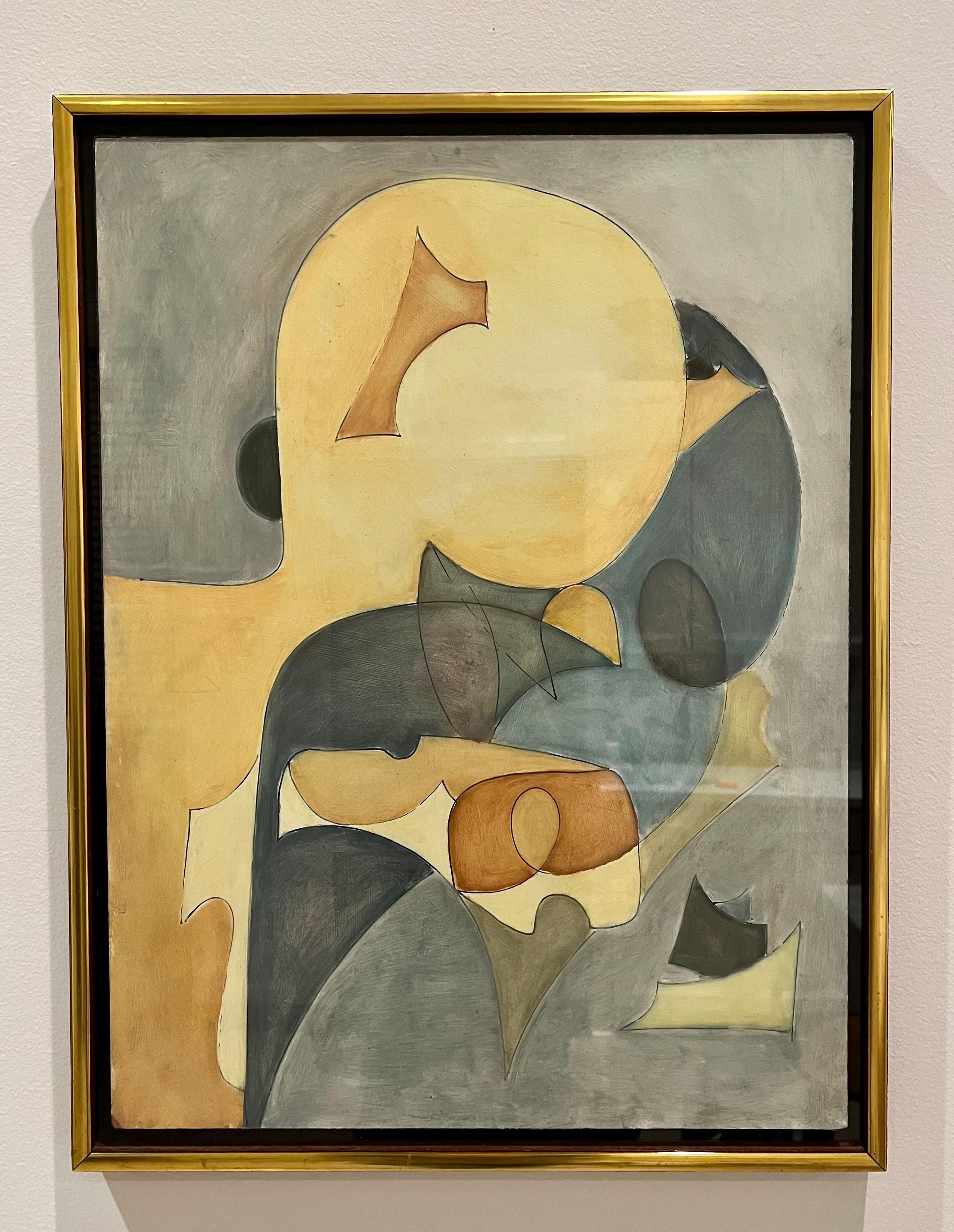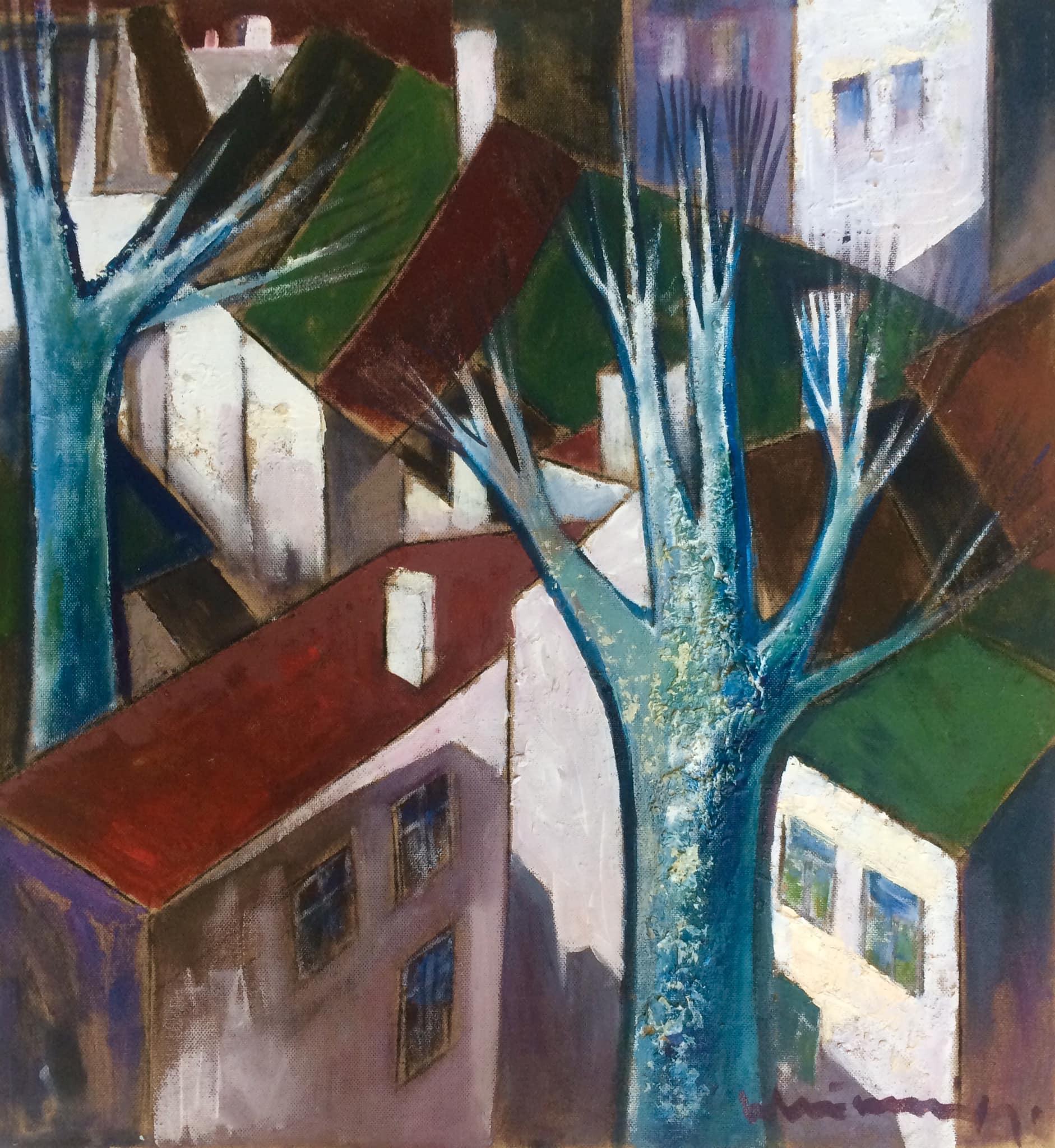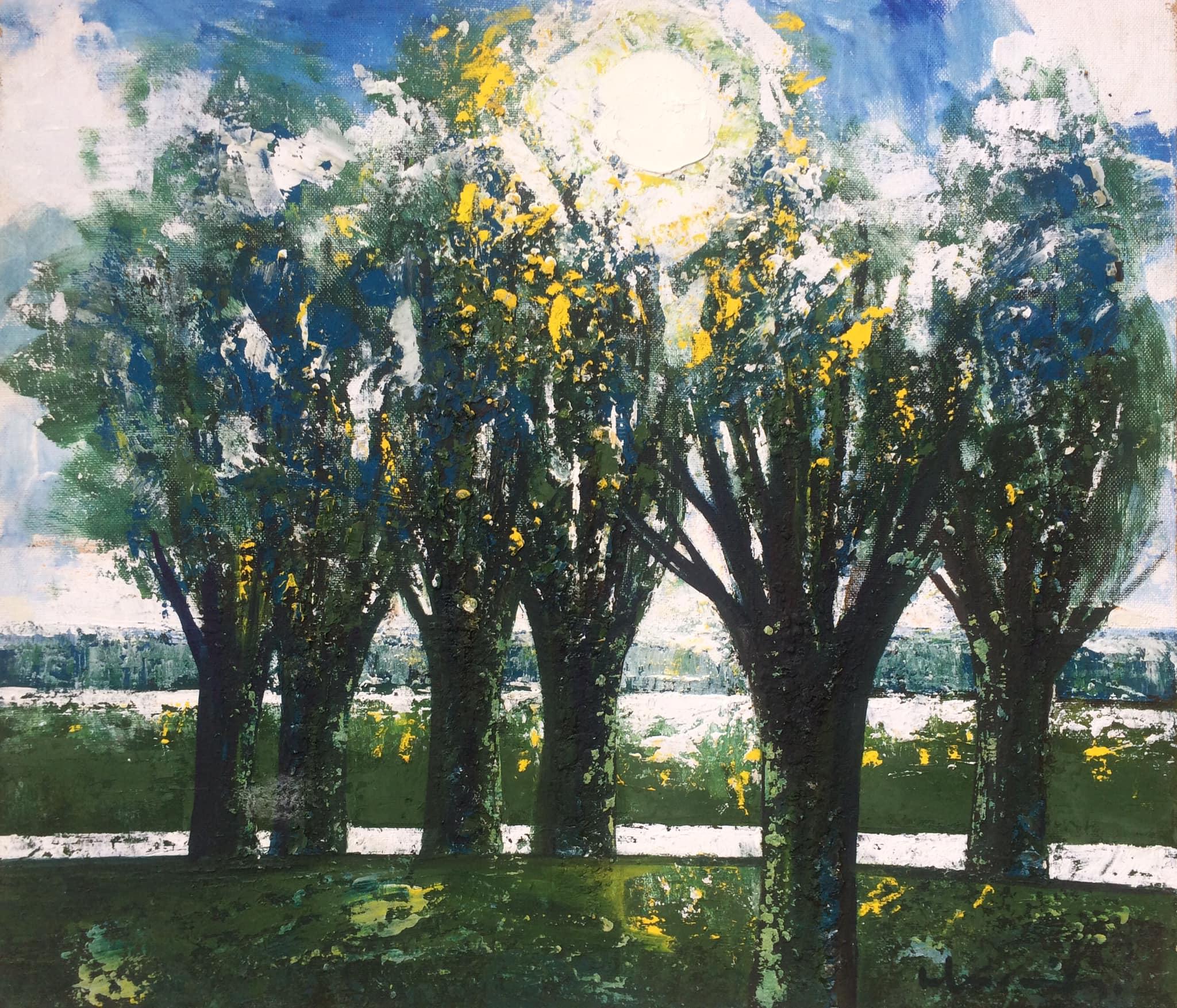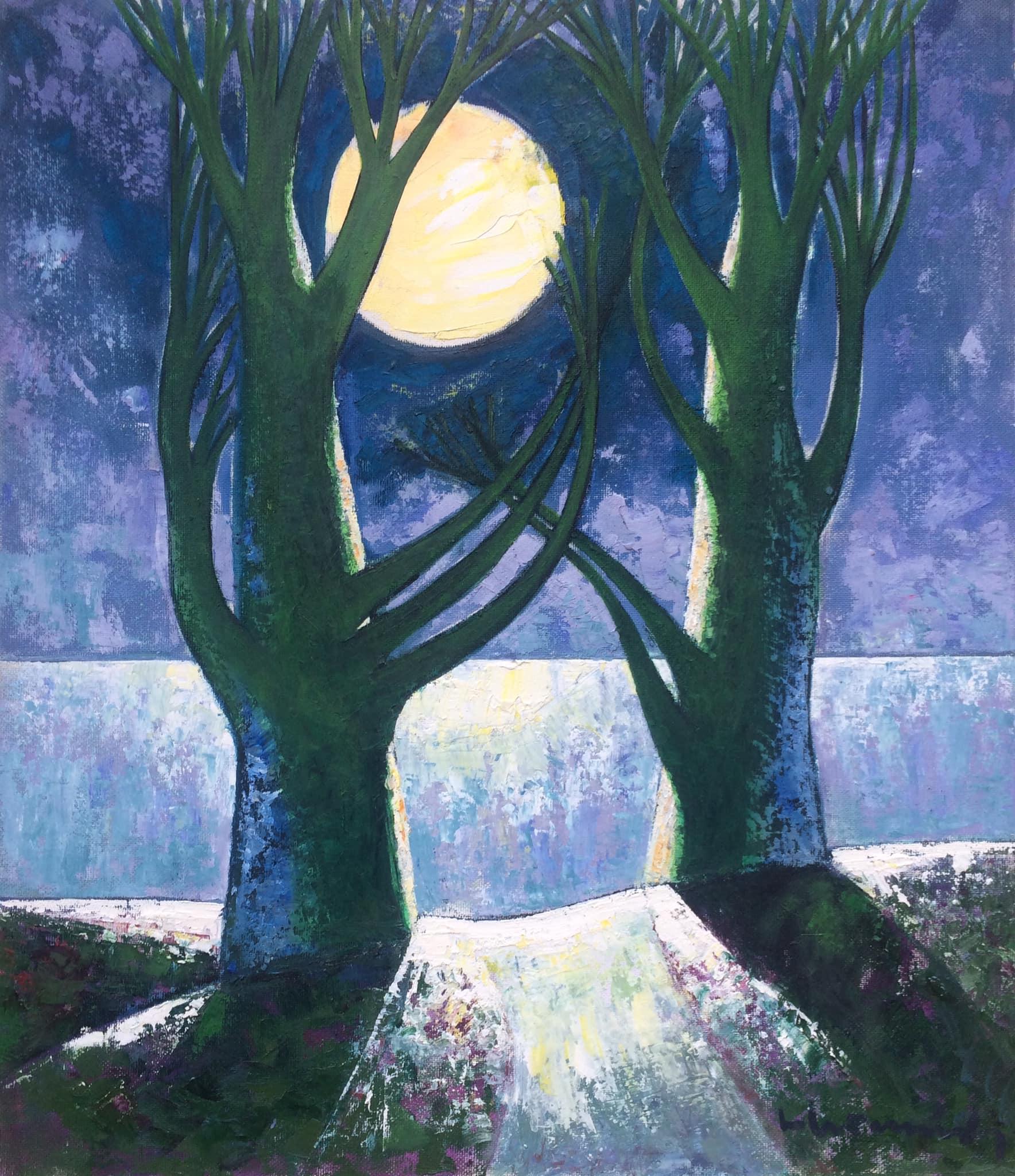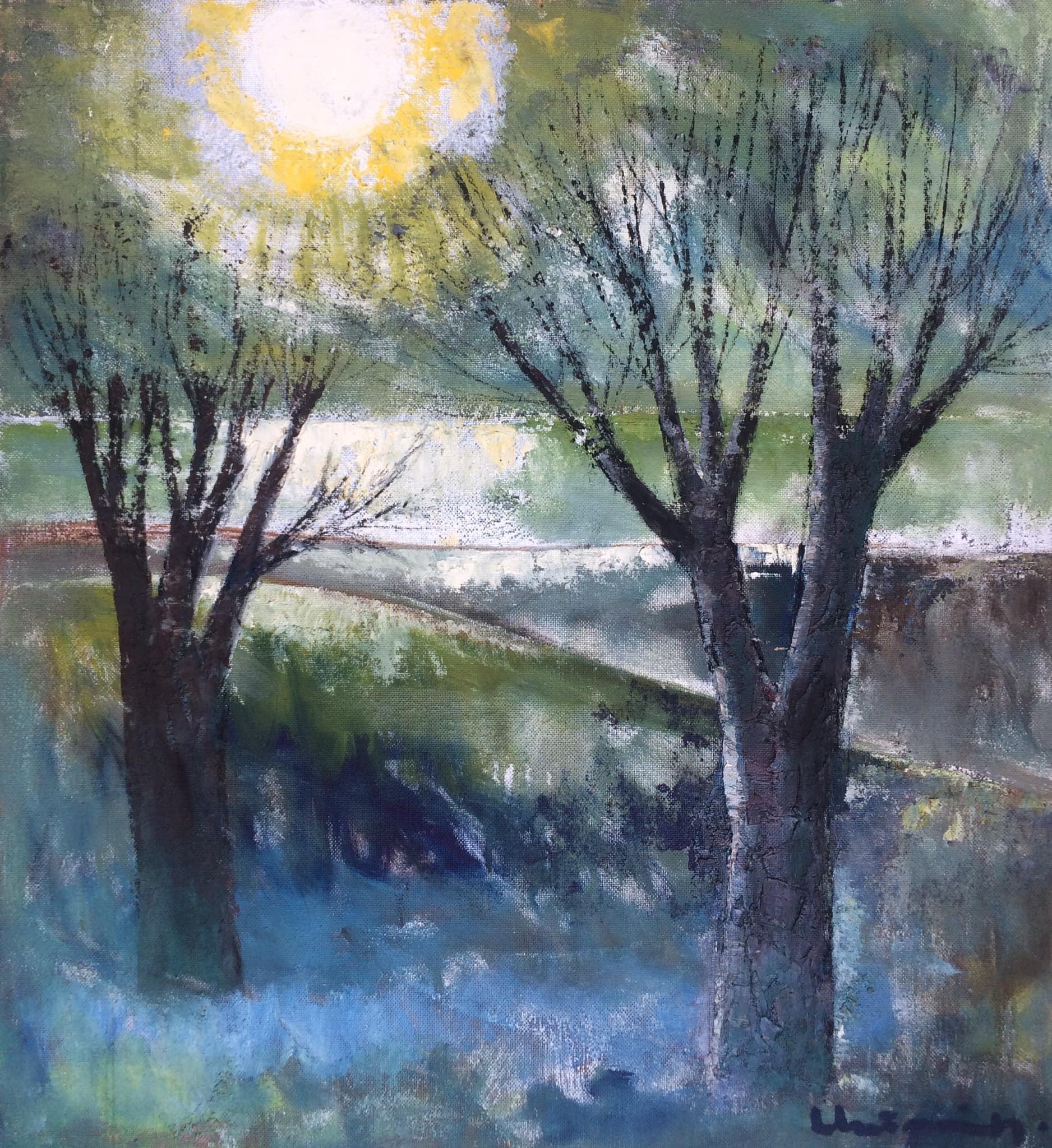Items Similar to Abstract Interior Scene
Want more images or videos?
Request additional images or videos from the seller
1 of 8
Abram TromkaAbstract Interior Scene
About the Item
Measures 16.5 X 20 without frame. heavy craquelure. it seems like some sort of experimental technique the artist used. paint is stable. please see photos Abram Tromka was born May 1, 1896 in Poland. At the age of seven he immigrated with his family to the United States, settling in New York City. It was on the boat coming to New York where Tromka first became interested in art. Fascinated by a woman who was painting, he decided that he wanted to become an artist. Upon arrival at immigration headquarters, Tromka’s family adopted the surname “Phillips,” which he kept until 1930. Hence the artist’s early works bear the signature — ‘A. Phillips.’
Having a rough childhood, Tromka left home at 15 and spent the remainder of his teenage years living at the Henry Street Settlement. Lilian D. Wald, founder and head of the settlement, was so impressed by young Tromka’s talent for art that the settlement began offering art classes. In 1915, she used his drawings and etchings to illustrate her book, The House on Henry Street. That same year, Tromka began his schooling at the Ferrer School, where he studied under Ashcan artists Robert Henri (1865-1929) and George Bellows (1882-1925) until 1922. Tromka was very impressed by the Ashcan style, and Henri and Bellows especially influenced his artistic development.
In 1927, Tromka befriended the curator of painting at the Brooklyn Museum, Herbert Tschudy who organized Tromka’s first solo exhibition at the museum in 1932. As a resident of Brooklyn, Tromka contributed to the New York arts throughout the rest of his artistic career, participating in many shows and exhibitions in galleries and museums, including the Metropolitan Museum of Art. Tromka’s work was most frequently shown at the ACA Gallery in New York City beginning in 1933. Following the success of his first Brooklyn Museum exhibition, his art was also shown throughout the country, and a traveling exhibition of serigraphs including his work was shown in the U.S.S.R.
As a member of the New York branch of the American Artists Congress, Tromka participated in membership exhibitions and served on the exhibition committee. He also participated in the Federal Art Project throughout its entire duration from 1935 to 1943. Rather than joining out of necessity, Tromka was invited to the WPA program to offer prestige to the Depression-era program. The industrial subject matter and style of his art during the Art Project continued to resonate with that of Henri’s and Bellows’ realist approach.
In 1946 and again in 1952, the Brooklyn Museum awarded Tromka for his merits in the visual arts. He continued working as an artist in New York City until his death in June of 1954.stable. Abram Tromka was born May 1, 1896 in Poland. At the age of seven he immigrated with his family to the United States, settling in New York City. It was on the boat coming to New York where Tromka first became interested in art. Fascinated by a woman who was painting, he decided that he wanted to become an artist. Upon arrival at immigration headquarters, Tromka’s family adopted the surname “Phillips,” which he kept until 1930. Hence the artist’s early works bear the signature — ‘A. Phillips.’
Having a rough childhood, Tromka left home at 15 and spent the remainder of his teenage years living at the Henry Street Settlement. Lilian D. Wald, founder and head of the settlement, was so impressed by young Tromka’s talent for art that the settlement began offering art classes. In 1915, she used his drawings and etchings to illustrate her book, The House on Henry Street. That same year, Tromka began his schooling at the Ferrer School, where he studied under Ashcan artists Robert Henri (1865-1929) and George Bellows (1882-1925) until 1922. Tromka was very impressed by the Ashcan style, and Henri and Bellows especially influenced his artistic development.
In 1927, Tromka befriended the curator of painting at the Brooklyn Museum, Herbert Tschudy who organized Tromka’s first solo exhibition at the museum in 1932. As a resident of Brooklyn, Tromka contributed to the New York arts throughout the rest of his artistic career, participating in many shows and exhibitions in galleries and museums, including the Metropolitan Museum of Art. Tromka’s work was most frequently shown at the ACA Gallery in New York City beginning in 1933. Following the success of his first Brooklyn Museum exhibition, his art was also shown throughout the country, and a traveling exhibition of serigraphs including his work was shown in the U.S.S.R.
As a member of the New York branch of the American Artists Congress, Tromka participated in membership exhibitions and served on the exhibition committee. He also participated in the Federal Art Project throughout its entire duration from 1935 to 1943. Rather than joining out of necessity, Tromka was invited to the WPA program to offer prestige to the Depression-era program. The industrial subject matter and style of his art during the Art Project continued to resonate with that of Henri’s and Bellows’ realist approach.
In 1946 and again in 1952, the Brooklyn Museum awarded Tromka for his merits in the visual arts. He continued working as an artist in New York City until his death in June of 1954.
- Creator:Abram Tromka (1890-1954, American)
- Dimensions:Height: 22 in (55.88 cm)Width: 25.5 in (64.77 cm)
- Medium:
- Movement & Style:
- Period:
- Condition:please see photos. heavy craquelure. I believe original to the piece.
- Gallery Location:Surfside, FL
- Reference Number:1stDibs: LU38211766262
About the Seller
4.9
Platinum Seller
These expertly vetted sellers are 1stDibs' most experienced sellers and are rated highest by our customers.
Established in 1995
1stDibs seller since 2014
1,547 sales on 1stDibs
Typical response time: 1 hour
- ShippingRetrieving quote...Ships From: Surfside, FL
- Return PolicyA return for this item may be initiated within 3 days of delivery.
More From This SellerView All
- Rocamadour, Modernist Abstract Architectural Village LandscapeBy Pierre (Baron) CourtensLocated in Surfside, FLPierre Courtens is a French painter of Belgian origin, born in Brussels in 1921 and died in Ribérac Dordogne in 2004. Baron Pierre Courtens is the third generation of painters with his brother Jacques Courtens , son of Hermann Courtens, grandson of Franz Courtens. His grandfather and then his father, director of the Royal Academy of Fine Arts of Brussels, were ennobled by the King of the Belgians...Category
Mid-20th Century Modern Abstract Paintings
MaterialsOil, Board
- Mixed Media Collage Oil Painting Futuristic Abstract Expressionist Machine ArtLocated in Surfside, FLNick de Angelis (June 21, 1921 – 2004) was an American artist who lived and worked most of his life in New York City. His work was widely recognized for its excellence until he becam...Category
20th Century Modern Abstract Paintings
MaterialsOil, Board
- Mixed Media Collage Oil Painting Futuristic Abstract Expressionist Machine ArtLocated in Surfside, FLThis work is not signed on the front. It comes from the estate of the artist. Nick de Angelis (June 21, 1921 – 2004) was an American artist who lived and worked most of his life in ...Category
20th Century Modern Abstract Paintings
MaterialsOil, Board
- Mixed Media Collage Oil Painting Futuristic Abstract Expressionist Machine ArtLocated in Surfside, FLNick de Angelis (June 21, 1921 – 2004) was an American artist who lived and worked most of his life in New York City. His work was widely recognized for its excellence until he becam...Category
20th Century Modern Abstract Paintings
MaterialsOil, Board
- Mixed Media Collage Oil Painting Futuristic Abstract Expressionist Machine ArtLocated in Surfside, FLNick de Angelis (June 21, 1921 – 2004) was an American artist who lived and worked most of his life in New York City. His work was widely recognized for its excellence until he becam...Category
20th Century Modern Abstract Paintings
MaterialsOil, Board
- Israeli Motke Blum Modernist Abstract Expressionist Oil Painting Bezalel ArtistBy Motke BlumLocated in Surfside, FLMotke Blum was born in Racacun, Romania in 1925. Early in his childhood, the Blum family moved to Bucharest where they settled in a house situated near a circus. The circus would become young Blum's greatest love. He befriended several of the clowns and other performers and, when not painting or playing in clay, Blum could be found enjoying the company of these spirited entertainers. These experiences would later become a recurring theme in many of his works of art. In 1938, he was taken by the Romanian Iron Guard. When the Germans invaded Romania, Blum was taken to a forced labor camp. Even during his imprisonment, he continued to create art, painting on the walls of the camp. He escaped the Nazi camp in 1944 and boarded an immigrants' ship to Israel. One of the three ships in the convoy was sunk by a German torpedo. Motke later incorporated shipwrecks, boats, and other maritime subjects into several of his paintings. Studies, Bezalel, Jerusalem, Enamel, Silversmithing, Painting and Sculpture. 1956 Seminar in the dep. of design in the royal silver factory of Zeist, The Netherlands. Over the course of his long and fruitful career, Blum showed internationally at over fifty one-man-shows with exhibits in Israel, Holland, England, Belgium, the United States, France, Australia, and more. His art has been commissioned for public buildings and by prominent figures in Israel and around the world, and a series of posters were commissioned by the Justice Ministry and the Ministry of Tourism. Group exhibition Rina Gallery, Jerusalem Artists: Motke Blum, Efraim Fima (Roytenberg, Ephraim) Zelig Segal, David Sharir, Joseph Halevi...Category
20th Century Modern Abstract Paintings
MaterialsMixed Media, Oil, Illustration Board
You May Also Like
- American School, Abstract UntitledLocated in New Orleans, LAAmerican School, Artist UnknownCategory
Early 20th Century American Modern Abstract Paintings
MaterialsOil, Board
- Roofs. 1991, oil on cardboard 91x85 cmLocated in Riga, LVLaimdots Murnieks had a significant influence on the development of Latvian painting at the end of the 20th century. His work 'Holiday' conveys the feeling lightness and joy, which i...Category
1990s Modern Landscape Paintings
MaterialsOil, Cardboard
- Spring. 1997, oil on cardboard, 74x85 cmLocated in Riga, LVLaimdots Murnieks had a significant influence on the development of Latvian painting at the end of the 20th century. His work 'Holiday' conveys the fee...Category
1990s Modern Landscape Paintings
MaterialsOil, Cardboard
- Moonlight. 1996. Oil on cardboard, 85x74 cmLocated in Riga, LVLaimdots Murnieks had a significant influence on the development of Latvian painting at the end of the 20th century. His work 'Holiday' conveys the fee...Category
1990s Modern Landscape Paintings
MaterialsOil, Cardboard
- After the rain. 1991, oil on cardboard, 90x83 cmLocated in Riga, LVLaimdots Murnieks had a significant influence on the development of Latvian painting at the end of the 20th century. His work 'Holiday' conveys the fee...Category
1990s Modern Landscape Paintings
MaterialsOil, Cardboard
- Moonlight. 2000, cardboard, oil, 81x100 cmLocated in Riga, LVLaimdots Murnieks had a significant influence on the development of Latvian painting at the end of the 20th century. His work 'Holiday' conveys the f...Category
Early 2000s Modern Landscape Paintings
MaterialsOil, Cardboard
Recently Viewed
View AllMore Ways To Browse
Interior Vintage House
Interior Vintage Houses
Vintage Style Homes Interior
Vintage Style Home Interiors
Era Interiors
Travel Scene
Modern House Vintage Interior
Modern Vintage House Interior
Abstract Street Scenes
Boat Scene
Abstract 1952
Oil Country Scene
Abstract Art From The 1930s
Abstract Branches
New York Is Book Country
Brooklyn Scene Paintings
Henry Street
Abstract Boats
